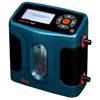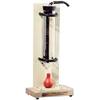 When completing integrated air sampling, calibration of the air sampling pumps to the desire flow rate is essential in the proper collection of the contaminant and in reducing variability in the sampling. Calibration must be completed prior to and following the air sampling event using a calibration source that can be traced to a NIST primary calibration standard.
When completing integrated air sampling, calibration of the air sampling pumps to the desire flow rate is essential in the proper collection of the contaminant and in reducing variability in the sampling. Calibration must be completed prior to and following the air sampling event using a calibration source that can be traced to a NIST primary calibration standard.
Most safety and health professionals use a "dry calibration device" or "bubble tube device" to complete calibration. The calibration should be completed with the air sampling train (pump, tubing, sampling cassette/tube holder, and cassette/tube) in place. If completing air sampling for respirable particles, the cyclone should also be in place during calibration to ensure accuracy. You can obtain the required sample flow rate or flow rate range from the analytical method.
 If you know the flow rate you may adjust your air sampling pump with the air sampling train in line to ensure that you set the air sampling pump at the correct flow rate. Sampling after the sampling event, called post-calibration, ensures nothing went wrong with your air sampling pump to cause an adjustment in the flow rate. Ideally, the post-calibration check is performed with the media used for air sampling in place to account for increased resistance due to captured contaminant. The post-calibration flow rate should not vary from the initial or pre-calibration flow rate by more than 5-10% as increased variability due to flow rate fluctuations is difficult to account for.
If you know the flow rate you may adjust your air sampling pump with the air sampling train in line to ensure that you set the air sampling pump at the correct flow rate. Sampling after the sampling event, called post-calibration, ensures nothing went wrong with your air sampling pump to cause an adjustment in the flow rate. Ideally, the post-calibration check is performed with the media used for air sampling in place to account for increased resistance due to captured contaminant. The post-calibration flow rate should not vary from the initial or pre-calibration flow rate by more than 5-10% as increased variability due to flow rate fluctuations is difficult to account for.

